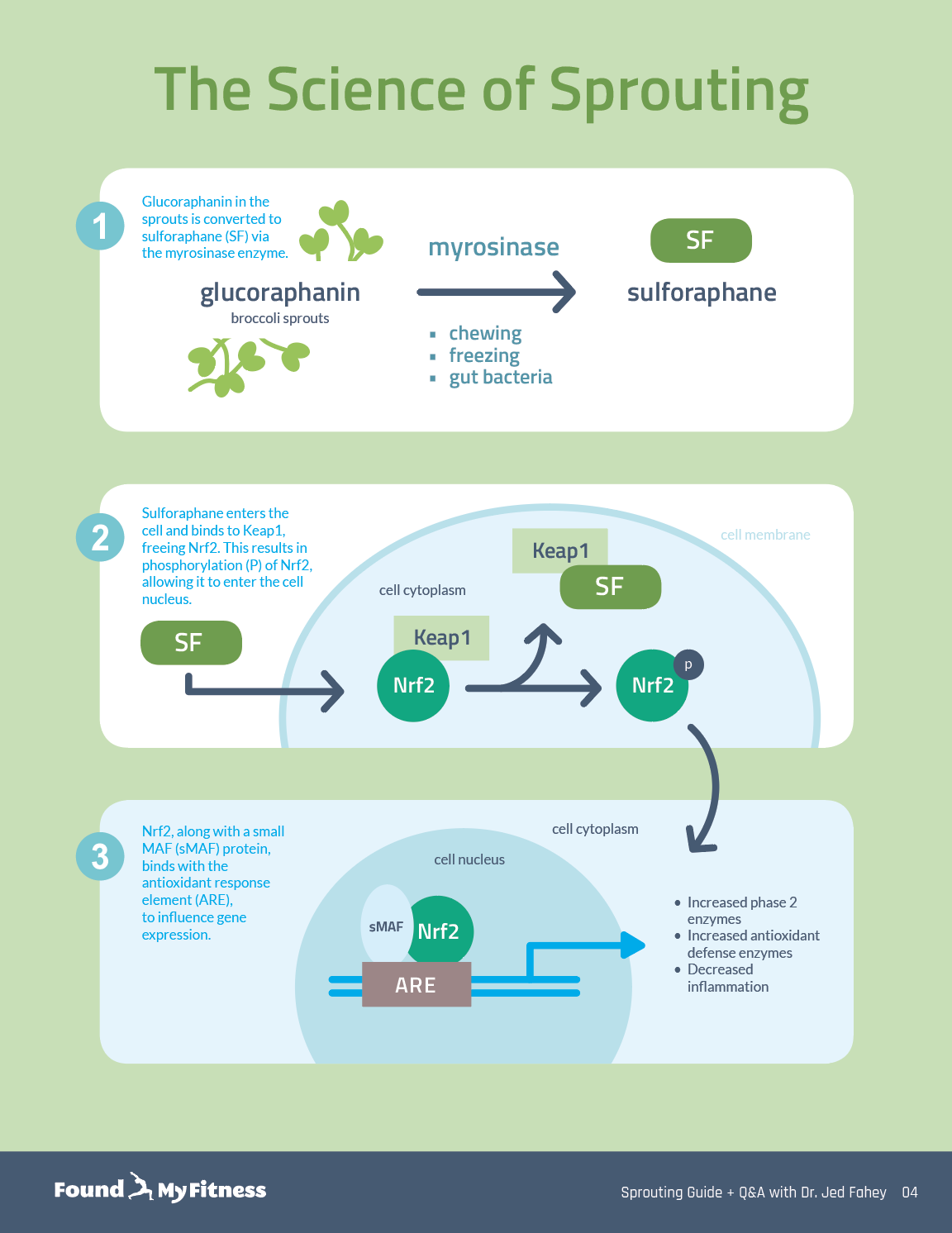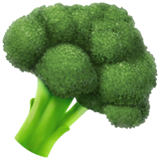Stability and heat sensitivity of myrosinase enzyme in cruciferous vegetables | Jed Fahey
Enter your email to get our 15-page guide to sprouting broccoli and learn about the science of chemoprotective compount sulforaphane.
Broccoli sprouts are concentrated sources of sulforaphane, a type of isothiocyanate. Damaging broccoli sprouts – when chewing, chopping, or freezing – triggers an enzymatic reaction in the tiny plants that produces sulforaphane.

Get the full length version of this episode as a podcast.
This episode will make a great companion for a long drive.
The hydrolytic conversion of glucoraphanin to sulforaphane requires myrosinase, an enzyme co-located within the leaves, stems, and other components of the plants in which it is found. In humans, myrosinase-producing gut bacteria can convert unhydrolyzed glucosinolates to their cognate isothiocyanates, as well. Microbial-induced conversion is highly variable (ranging from 10 to 70 percent) and subject to interindividual differences in gut bacteria populations. As such, conversion is distinguished by “high converters,” – people with high elimination profiles, and “low converters,”– those with low elimination profiles. In this clip, Dr. Jed Fahey describes some of the factors that influence the conversion of myrosinase-driven conversion of glucoraphanin to sulforaphane.
Rhonda: You made a pretty important point for people and that is that the myrosinase enzyme is heat-sensitive and as you pointed out, most people like to cook their cauliflower and broccoli or slightly steam it and their trade-off for that is maybe it tastes a little better, but also it inactivates the myrosinase enzyme.
Jed: Correct.
Rhonda: So they're not actually getting as much sulforaphane from the glucoraphanin as they would have if they were to just chew on that raw broccoli. But what about the myrosinase enzyme? Is the stability the same throughout all the cruciferous family? So, like, if you look at the broccoli sprouts versus the mature broccoli or kale?
Jed: So myrosinase appears to be about as stable throughout the family. There are differences, subtle differences to the protein composition of myrosinase. This is in different cruciferous vegetables, to be sure. Subtle enough so that I can’t even describe them to you. I mean, they're minor differences, but they certainly must confer increased or decreased stability or catalytic ability on those molecules. Interestingly, if you ingest glucoraphanin or glucosinolates without myrosinase at all, you then can count on the bacteria in your gut, in your intestines, primarily, to make that conversion. And sometimes scientists think they're so darn smart. Just to back up just a little bit, we observed that when you delivered just glucoraphanin to people, just give them one dose, one reasonable amount that which they would get in a serving of broccoli, and then we collected their urine for 24 hours. We asked them to collect their urine for 24 hours, so you get a full 24-hour collection which pretty much spans the period during which the enzyme myrosinase acts, sulforaphane goes into cells, gets recognized, turns on Nrf2, gets spit back out, and then gets excreted in the urine.
So by collecting a 24-hour urine, we can get a very good idea of how much bioavailability there is, how much metabolism and availability. And it turns out that if we looked at 100 different people, and we did, after giving them one dose of glucoraphanin, their bioavailability, the amount they gave back to us in their urine was all over the map. It ranged from very, very little, but always something to 40% or 50%, or even 60% or 70% of what we gave them. But the mean was pretty low. It was about 10%. So most people converted, and metabolized, and excreted only about 10% of what they were given. So, when you give sulforaphane itself, the end product, the active ingredient, if you will, we get more, like, 70%, 75%, 80% bioavailability. Still a bit of variability person-to-person, but since we're up sort of near maximum, it appeared to be not as great. Well, it was not as great in terms of a percent of the whole. So that sounds a little convoluted. But essentially most sulforaphane came back at us in the urine and was available. So, in our infinite wisdom, we thought if we co-deliver myrosinase, if we give these people active myrosinase in addition to glucoraphanin, they're all going to give back 70% to 90% of the metabolites and we'll get rid of the variability person-to-person. Didn't happen that way.
Rhonda: Really?
Jed: Really. It didn't happen that way. What did happen is that we moved the bar up so that instead of 10% bioavailability for 70%, we had about 35% or 40%. So the average moved up substantially. It was about three or four times more, but there was still quite large person-to-person variability. So we have to sort of step back a little bit and say, "Yes, this is due to intrinsic myrosinase activity in the gut because certainly, we hadn't done anything to get rid of that. That was still acting on these molecules.
But also just innate mammalian genetics, differences between you and me and the way we process these metabolites once they're formed, differences in absorption, differences in distribution, in metabolism. So there's a lot we still don't know. There's a whole lot we still don't know. But as a result of this sort of cocky thinking that we could abolish this variability and at least have a very predictable amount delivered to people, we did learn that we can greatly increase bioavailability by delivering it with myrosinase. And, in fact, there are now companies that are selling glucoraphanin plus myrosinase. You have to be careful if you buy those supplements because it's not a given that they're going to be as stable as multivitamins and things that you can just leave on the shelf for years.
So you need to pay attention to the expiration dates on those products that have live active enzyme.
The extent and rate at which drugs or other substances, such as plant-based dietary compounds, enter the body’s circulation. Bioavailability is influenced by a variety of factors, including dose, the presence of other foods or substances, and interindividual differences in metabolism due to gut absorptive surface and commensal microbial populations.
A class of edible plants from the Brassicaceae, Capparaceae, and Caricaceae families, so named for their cross-shaped flowers. Crucifers contain glucosinolates and myrosinase, which react to form isothiocyanates, a class of compounds with known beneficial health effects in humans. Cruciferous vegetables include arugula, broccoli, bok choy, Brussels sprouts, cabbage, capers, cauliflower, cress, collards, kale, kohlrabi, moringa, mustard, papaya, radish, rutabaga, turnips, wasabi, and watercress.
Any of a group of complex proteins or conjugated proteins that are produced by living cells and act as catalyst in specific biochemical reactions.
A glucosinolate (see definition) found in certain cruciferous vegetables, including broccoli, Brussels sprouts, and mustard. Glucoraphanin is hydrolyzed by the enzyme myrosinase to produce sulforaphane, an isothiocyanate compound that has many beneficial health effects in humans.
Plant secondary metabolites found primarily in cruciferous vegetables. Glucosinolates give rise to a variety of compounds that have been identified as potent chemoprotective agents in humans against the pathogenesis of many chronic diseases such as cancer, cardiovascular disease, and neurodegenerative disease, among others. These products are responsible for the pungent aroma, sharp flavor, and the “heat” commonly associated with some cruciferous vegetables such as wasabi and horseradish.
A class of proteins present in many edible plants, such as grains or legumes. Lectins are carbohydrate-binding molecules. They have been referred to as antinutrients for their ability to impair absorption of some nutrients. Many lectins possess hemagglutinin properties, which means they can bind to blood cells and cause them to aggregate. Cooking typically denatures lectins in foods.
The thousands of biochemical processes that run all of the various cellular processes that produce energy. Since energy generation is so fundamental to all other processes, in some cases the word metabolism may refer more broadly to the sum of all chemical reactions in the cell.
A family of enzymes whose sole known substrates are glucosinolates. Myrosinase is located in specialized cells within the leaves, stems, and flowers of cruciferous plants. When the plant is damaged by insects or eaten by humans, the myrosinase is released and subsequently hydrolyzes nearby glucosinolate compounds to form isothiocyanates (see definition), which demonstrate many beneficial health effects in humans. Microbes in the human gut also produce myrosinase and can convert non-hydrolyzed glucosinolates to isothiocyanates.
A protein typically present in the cytoplasm of mammalian cells. Nrf2 can relocate to the nucleus where it regulates the expression of hundreds of antioxidant and stress response proteins that protect against oxidative damage triggered by injury and inflammation. One of the most well-known naturally-occurring inducers of Nrf2 is sulforaphane, a compound derived from cruciferous vegetables such as broccoli.
An isothiocyanate compound derived from cruciferous vegetables such as broccoli, cauliflower, and mustard. Sulforaphane is produced when the plant is damaged when attacked by insects or eaten by humans. It activates cytoprotective mechanisms within cells in a hormetic-type response. Sulforaphane has demonstrated beneficial effects against several chronic health conditions, including autism, cancer, cardiovascular disease, diabetes, and others.
Supporting our work
If you enjoy the fruits of
 , you can participate in helping us to keep improving it. Creating a premium subscription does just that! Plus, we throw in occasional member perks and, more importantly, churn out the best possible content without concerning ourselves with the wishes of any dark overlords.
, you can participate in helping us to keep improving it. Creating a premium subscription does just that! Plus, we throw in occasional member perks and, more importantly, churn out the best possible content without concerning ourselves with the wishes of any dark overlords.
Sulforaphane News
- Broccoli seed extract with a sulforaphane precursor reduced common cold symptom days in healthy adults.
- Sulforaphane-rich broccoli sprout extract modestly lowers fasting blood sugar in some people with prediabetes, perhaps due to variations in gut microbiota and individual metabolic traits.
- Sulforaphane, derived from broccoli, activates Nrf2, mitigating age-related skin changes and boosting the antioxidant defense system in mice.
- Sulforaphane from broccoli sprouts shows promise in preventing Alzheimer's disease – boosting memory and enhancing mitochondrial function in mice.
- Breathwork enhances endogenous antioxidant enzyme activity to counter oxidative stress.






